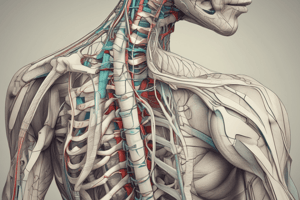Podcast
Questions and Answers
Which cranial nerve provides GSE (motor) innervation to the soft palate?
Which cranial nerve provides GSE (motor) innervation to the soft palate?
- Vagus nerve (X)
- Facial nerve (VII)
- Glossopharyngeal nerve (IX)
- Hypoglossal nerve (XII) (correct)
Which nerve is responsible for taste sensation from the palate?
Which nerve is responsible for taste sensation from the palate?
- Lingual nerve (V3)
- Facial nerve (VII) (correct)
- Glossopharyngeal nerve (IX)
- Trigeminal nerve (V2)
Which nerve innervates the glands of the palate with parasympathetic fibers?
Which nerve innervates the glands of the palate with parasympathetic fibers?
- Vagus nerve (X)
- Facial nerve (VII)
- Glossopharyngeal nerve (IX)
- Trigeminal nerve (V2) (correct)
Which nerve carries sensory fibers to the anterior two-thirds of the tongue?
Which nerve carries sensory fibers to the anterior two-thirds of the tongue?
Which nerve innervates the submandibular gland?
Which nerve innervates the submandibular gland?
Which cranial nerve is responsible for GSA innervation of the palate primarily through the greater and lesser palatine nerves?
Which cranial nerve is responsible for GSA innervation of the palate primarily through the greater and lesser palatine nerves?
Where do the majority of blood supply to the palate come from?
Where do the majority of blood supply to the palate come from?
Which artery primarily supplies blood to the floor of the oral cavity and tongue?
Which artery primarily supplies blood to the floor of the oral cavity and tongue?
Where are the preganglionic parasympathetic nerve cell bodies located for the submandibular and sublingual salivary glands?
Where are the preganglionic parasympathetic nerve cell bodies located for the submandibular and sublingual salivary glands?
Which nerve carries preganglionic parasympathetic fibers to the submandibular ganglion?
Which nerve carries preganglionic parasympathetic fibers to the submandibular ganglion?
Where do the deep and dorsal lingual veins drain to?
Where do the deep and dorsal lingual veins drain to?
Which cranial nerve is responsible for the motor innervation of the genioglossus muscle?
Which cranial nerve is responsible for the motor innervation of the genioglossus muscle?
In which pharyngeal arch is the posterior 1/3 of the tongue formed?
In which pharyngeal arch is the posterior 1/3 of the tongue formed?
Which cranial nerve provides motor innervation to the hyoglossus muscle?
Which cranial nerve provides motor innervation to the hyoglossus muscle?
What causes the tongue to deviate toward the injured side in a lesion of the hypoglossal nerve (CN XII)?
What causes the tongue to deviate toward the injured side in a lesion of the hypoglossal nerve (CN XII)?
Which cranial nerve provides motor innervation to the palatoglossus muscle involved in elevating the posterior tongue during swallowing?
Which cranial nerve provides motor innervation to the palatoglossus muscle involved in elevating the posterior tongue during swallowing?
What makes up the oral cavity
What makes up the oral cavity
Match the following tongue muscles with their innervating nerve:
Match the following tongue muscles with their innervating nerve:
Match the following tongue muscle actions with their description:
Match the following tongue muscle actions with their description:
Match the following structures with their description related to the tongue:
Match the following structures with their description related to the tongue:
Match the following actions with their corresponding muscle involved in tongue movement:
Match the following actions with their corresponding muscle involved in tongue movement:
Match the following nerve types with their functions in tongue innervation:
Match the following nerve types with their functions in tongue innervation:
Match the following soft palate muscles with their respective functions:
Match the following soft palate muscles with their respective functions:
Match the following parts of the tongue with their innervations:
Match the following parts of the tongue with their innervations:
Match the major salivary glands with their associated features:
Match the major salivary glands with their associated features:
Match the following neurovascular structures with their locations in the oral cavity:
Match the following neurovascular structures with their locations in the oral cavity:
Match the functional anatomy descriptions with their corresponding structures:
Match the functional anatomy descriptions with their corresponding structures:
Match the following salivary gland structure with its description:
Match the following salivary gland structure with its description:
Match the following nerve type with its function in palate innervation:
Match the following nerve type with its function in palate innervation:
Match the following nerve with its role in innervating the glands of the palate:
Match the following nerve with its role in innervating the glands of the palate:
Match the pharyngeal arches with the parts of the tongue they form:
Match the pharyngeal arches with the parts of the tongue they form:




